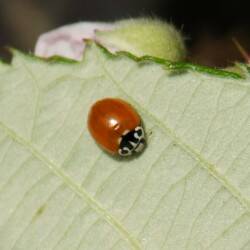by Russel Barsh
Director, Kwiaht
An iconic small native ladybug beetle that looks like a drop of blood — with a clown face!
Ladybugs are a distinctive, brightly colored family of small oval beetles, the Coccinellidae (from coccineus, “scarlet”), which despite their charm are voracious predators. Most of the 6,000 or so species of ladybugs live in temperate climates and subsist chiefly on aphids, both as somewhat lizard-like larvae and as the more familiar adults.
Among insects, ladybugs are relative newcomers that first appeared during the Eocene about 40 million years ago, during the same period of cooling, temperate planetary climate conditions as the first modern rodents, primates and whales. They are hugely diverse in color patterns but vary very little in their basic anatomy, behavior and ecology.
The blood-red ladybug is one of nearly 200 ladybug species found on the Pacific Coast, from British Columbia to southern California. For a beginner, it is easy to tell apart because it has no dark spots on its deep red elytra — the rigid wing covers that form most of what we see from above. Look more closely, and the small black collar-like pronotum has two open white rings that mimic eyes. The ladybug’s tiny head, with its true, black compound eyes, is almost hidden — as are the scissors-like mandibles that this diminutive insect will use to devour more than 500 aphids during its short lifetime.
Cycloneda polita (“polished little round one” in Latin) lays clutches of five to 10 eggs right in the middle of aphid infestations so that its larval offspring, when they emerge a few days later, have plenty of food at hand to fuel their rapid growth and metamorphoses into adults over the next several weeks. In our moderate Salish Sea climate, ladybugs can produce two or three generations of offspring in a summer, and the new adults may survive their first winter to produce even more offspring in the following year.
Ladybugs produce foul-smelling, mildly toxic chemical compounds that are relatively effective at discouraging would-be predators such as birds. The main limiting factor on ladybug populations is the abundance of aphids.
Different ladybug species can compete for aphids, however. Two species of nonnative ladybugs originally introduced as bio-controls for farms and gardens have become highly invasive, and now represent a majority of the ladybugs that we encounter in the islands — even on protected public conservation lands.
Introduced on the Gulf Coast in the 1970s, the multicolored Asian ladybug, Harmonia axyridis, is now well established throughout temperate North America. It is larger and more aggressive than most of our native ladybugs, and sometimes bites if handled. Swarms are known to invade human homes so they can over-winter indoors. Multicolored ladybugs may also spread parasites such as mites and nematode worms to native ladybug populations.
Intriguingly, multicolored ladybugs are also shape-shifters, assuming dozens of different colorful patterns that can result in confusing them with native North American species.
Another introduced species is the seven-spot ladybug, Coccinella septempunctata, native to Europe, which as its name suggests has seven neatly symmetrical dark spots on its elytra. Like the multicolored ladybug, Seven-spots were introduced in the 1970s on the East Coast as a bio-control and then spread rapidly across the continent.
There is still a burgeoning market for ladybugs, and sellers rarely identify which species are in the box. When we last looked, there were 45 different offers of ladybugs on Amazon, for example; more than half of them simply referred to “ladybugs.”
One cosmopolitan North American species, Hippodamia convergens, is easily raised in captivity and is most likely to be sold to gardeners. It is native here; but why buy boxes of a single species to compete with other ladybug species in the islands? Reducing diversity makes our local ladybug community less resilient to climate change and disease.
(Kwiaht participates in Cornell University’s Lost Ladybug Project (www.lostladybug.org), which aims to raise awareness of the diversity of ladybug species, and to protect and recover species that are threatened by habitat loss or competition with introduced species.)



